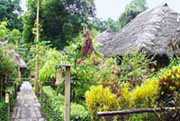 |
|
| Amazon Jungle |
 |
|
|
|

The Amazon jungle is the green heart of South America, the largest expanse of rainforest on the planet.
The tropical forest may seem like the Garden of Eden, but much of what grows here is forbidden fruit―packed with poisons like strychnine, morphine and cocaine, even leaves are off limits. There are plenty of them, but most are so toxic that they're inedible.
Up in the trees spider monkeys are in their elements, and have few natural predators. But down here they're vulnerable. Something in the mud must be absolutely vital for them to take such a risk.
A brocket deer is here for the same thing. Like the monkeys, it's risking its life to come here...
For all kinds of animals, a visit to a clay lick is a regular part of their routine. But it has to be just the right kind of clay. Good licks are few and far between. Like waterholes on the African savannah, they're focus of activity...but you can never drop your guard.
When the sun comes out, the lick becomes even more dangerous. Predators are harder to spot.
Monkeys rely on their good eyesight. When it's overcast, there's no problem, but the tropical sun casts deep shadows and they find it hard to cope with the contrast. Does that twitching leaf hide a stealthy jaguar? Is there a puma in that shadow? Coming to a clay lick is obviously very risky, so there must be a good reason for many animals to do it.
People used to think that animals ate soil just to obtain salt. But some of these licks are no richer in salt than their natural diet, so that's only part of the story. Recent research shows that some kinds of clay neutralize many of the toxic plants use to defend themselves either by combining with them chemically or by lining the gut with a protective coating. That's why animals risk their lives to come here. Without clay to counteract the toxins, much of what grows in the forest would be simply impossible to eat.
("Man and Nature", CCTV-1, December 19)
|
|
| Editor: Zhao Xuan CCTV.com |
|
|
|
|
|
 |



